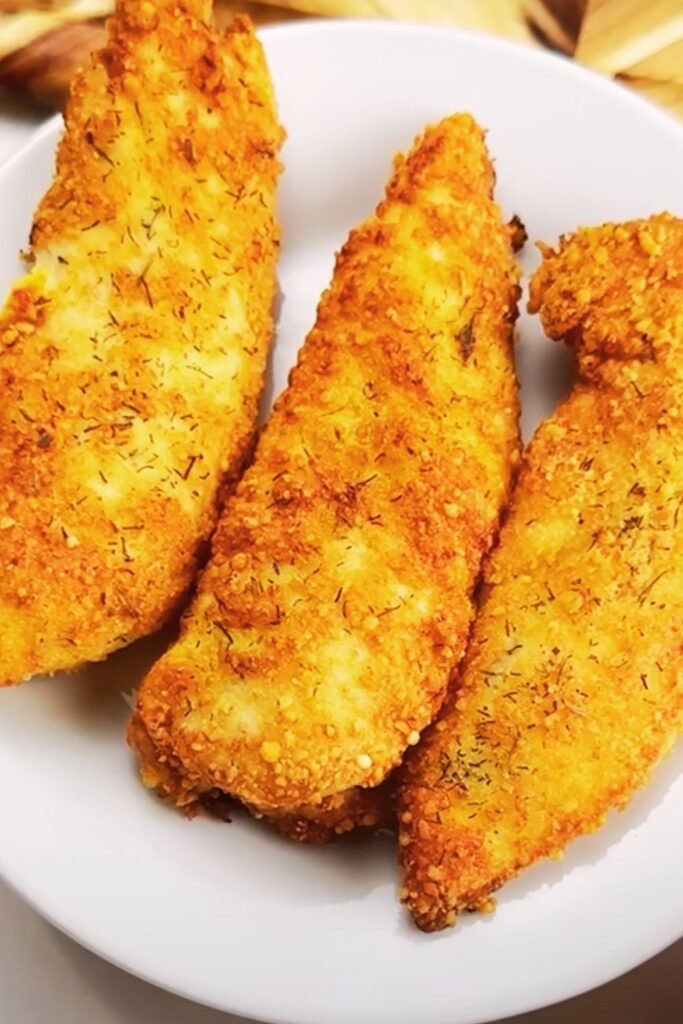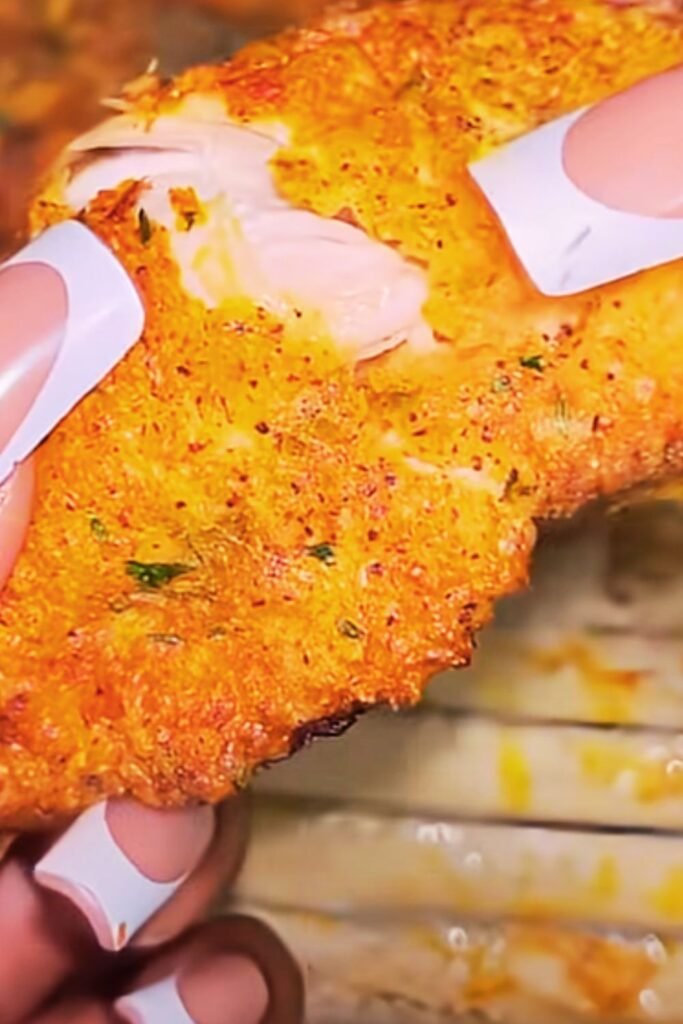Growing up, I always associated crispy chicken tenders with deep frying and the inevitable mess that came with it. My kitchen would be splattered with oil, and I’d spend ages cleaning up afterward. That’s when I discovered the magic of oven-baked chicken tenders, and honestly, it changed my entire approach to cooking this beloved comfort food.
The beauty of oven-baked chicken tenders lies in their ability to deliver that satisfying crunch we all crave without the hassle and health concerns of deep frying. I’ve spent years perfecting my technique, and I’m excited to share everything I’ve learned with you. These tenders are not just healthier – they’re incredibly flavorful, consistently crispy, and surprisingly simple to make.
Understanding Chicken Tenders
Chicken Tenderloins : The small, tender muscle that runs alongside the breast meat, naturally lean and quick-cooking
Breading Station : A systematic setup of flour, egg wash, and breadcrumb coating for consistent results
Maillard Reaction : The chemical process that creates browning and develops complex flavors when proteins and sugars are heated
Internal Temperature : The safe cooking temperature of 165°F (74°C) that ensures chicken is fully cooked
When I first started making these, I didn’t realize how important it was to understand the cut of meat I was working with. Chicken tenderloins are naturally the most tender part of the chicken, which makes them perfect for this cooking method. They cook evenly and quickly, reducing the risk of drying out that can happen with larger chicken pieces.
The Science Behind Perfect Oven-Baked Tenders
The key to achieving restaurant-quality crispiness in your home oven lies in understanding moisture control and heat distribution. Unlike deep frying, where oil conducts heat rapidly and creates steam barriers, oven baking relies on dry heat and proper breading technique.
I’ve discovered that the secret is in the three-stage breading process combined with strategic oven positioning. The flour creates a base layer that helps the egg adhere, while the egg acts as glue for the breadcrumbs. But here’s what most people miss – the type of breadcrumbs you use makes all the difference.
Essential Ingredients and Equipment
Core Ingredients
| Ingredient | Quantity | Purpose | Substitutions |
|---|---|---|---|
| Chicken Tenderloins | 2 lbs | Main protein | Chicken breast strips |
| All-purpose Flour | 1 cup | Base coating | Gluten-free flour blend |
| Large Eggs | 2 | Binding agent | Buttermilk for dairy-free |
| Panko Breadcrumbs | 2 cups | Crispy exterior | Regular breadcrumbs + cornmeal |
| Paprika | 2 tsp | Color and flavor | Smoked paprika for depth |
| Garlic Powder | 1 tsp | Savory element | Fresh minced garlic |
| Onion Powder | 1 tsp | Aromatic base | Dried onion flakes |
| Salt | 1.5 tsp | Flavor enhancer | Sea salt or kosher salt |
| Black Pepper | 0.5 tsp | Spice element | White pepper |
| Cooking Spray | As needed | Browning aid | Olive oil brush |
Equipment Essentials
- Large rimmed baking sheet
- Wire cooling rack
- Three shallow dishes for breading station
- Meat thermometer
- Paper towels
- Kitchen tongs

Step-by-Step Preparation Method
Preparation Phase
I always start by setting up my workspace efficiently. This isn’t just about organization – it’s about ensuring consistent results every single time.
Setting Up Your Breading Station:
- Place flour mixture in the first shallow dish
- Beat eggs with 2 tablespoons of water in the second dish
- Combine panko breadcrumbs with all seasonings in the third dish
- Line up dishes in order: flour, egg wash, seasoned breadcrumbs
The Breading Process
- Pat chicken tenderloins completely dry – This step is crucial for adhesion
- Season chicken lightly with salt and pepper before breading
- Dredge in flour mixture, shaking off excess
- Dip in egg wash, allowing excess to drip off
- Press into breadcrumb mixture, ensuring complete coverage
- Place on wire rack set over baking sheet
The pressing motion in the breadcrumbs is something I learned through trial and error. Simply dropping the chicken into the crumbs doesn’t create the adherence you need. I gently press and turn each tender, making sure the coating sticks properly.
Optimal Cooking Technique
Temperature and Timing Chart:
| Oven Temperature | Cooking Time | Internal Temp | Visual Cues |
|---|---|---|---|
| 425°F (220°C) | 15-18 minutes | 165°F (74°C) | Golden brown exterior |
| 450°F (232°C) | 12-15 minutes | 165°F (74°C) | Deep golden color |
| 400°F (204°C) | 18-22 minutes | 165°F (74°C) | Light golden brown |
I prefer the 425°F temperature because it strikes the perfect balance between cooking the chicken through and achieving that crispy exterior. Higher temperatures risk burning the breadcrumbs before the chicken cooks completely.
My Baking Method:
- Preheat oven to 425°F with rack in upper third position
- Spray wire rack with cooking spray
- Arrange breaded tenders on rack, not touching
- Lightly spray tops of tenders with cooking spray
- Bake for 15-18 minutes, flipping halfway through
- Check internal temperature reaches 165°F

Advanced Tips for Extra Crispiness
Through years of experimentation, I’ve developed several techniques that take these tenders from good to extraordinary:
The Double-Crumb Method: After the initial breading, let the tenders rest for 10 minutes, then repeat the egg wash and breadcrumb steps. This creates an extra-thick, ultra-crispy coating.
Breadcrumb Modifications: I sometimes mix panko with crushed cornflakes or even finely ground nuts for added texture and flavor. The key is maintaining the same volume while adding variety.
Temperature Tricks: Starting at 450°F for the first 5 minutes, then reducing to 425°F helps create an initial crispy seal while preventing overcooking.
Flavor Variations and Seasonings
Classic Seasoning Blends
| Blend Name | Key Ingredients | Flavor Profile | Best Paired With |
|---|---|---|---|
| Southern Style | Cayenne, paprika, garlic powder | Spicy, smoky | Honey mustard |
| Italian Herb | Oregano, basil, parmesan | Savory, aromatic | Marinara sauce |
| Asian-Inspired | Ginger powder, sesame seeds | Umami, nutty | Sweet and sour sauce |
| Mexican Fiesta | Cumin, chili powder, lime zest | Bold, citrusy | Avocado crema |
I rotate through these variations depending on my mood and what I’m serving alongside the tenders. The Italian herb version has become my family’s favorite for weeknight dinners.
Serving Suggestions and Pairings
The versatility of these chicken tenders never ceases to amaze me. I’ve served them as appetizers at parties, main courses for family dinners, and even chopped them up for salads.
Appetizer Presentations:
- Arrange on wooden boards with various dipping sauces
- Serve with fresh vegetable sticks and ranch dressing
- Create a “build-your-own” tender bar with multiple sauces
Main Course Ideas:
- Pair with roasted vegetables and mashed potatoes
- Serve over mixed greens for a protein-packed salad
- Use in wraps with fresh vegetables and sauce
Kid-Friendly Options:
- Cut into smaller pieces for little hands
- Serve with their favorite dipping sauces
- Pack in lunch boxes with fresh fruit
Sauce Pairing Guide
| Sauce Type | Flavor Notes | Preparation Difficulty | Storage Life |
|---|---|---|---|
| Honey Mustard | Sweet, tangy | Easy (5 minutes) | 2 weeks refrigerated |
| BBQ Sauce | Smoky, sweet | Easy (store-bought) | 1 month unopened |
| Ranch Dressing | Creamy, herby | Easy (5 minutes) | 1 week refrigerated |
| Buffalo Sauce | Spicy, buttery | Medium (10 minutes) | 2 weeks refrigerated |
| Garlic Aioli | Rich, garlicky | Medium (15 minutes) | 3 days refrigerated |

Storage and Reheating Guidelines
One of the questions I get most frequently is about storing and reheating these tenders. The good news is they keep remarkably well when stored properly.
Refrigerator Storage:
- Cool completely before storing
- Place in airtight containers with paper towels to absorb moisture
- Use within 3-4 days for best quality
- Keep sauces separate to prevent soggy coating
Freezer Storage:
- Freeze in single layers on baking sheets first
- Transfer to freezer bags once solid
- Label with date and contents
- Use within 3 months for optimal taste and texture
Reheating Methods:
| Method | Temperature | Time | Result Quality |
|---|---|---|---|
| Oven | 375°F | 8-10 minutes | Best crispiness |
| Toaster Oven | 375°F | 5-7 minutes | Good crispiness |
| Air Fryer | 350°F | 3-5 minutes | Excellent crispiness |
| Microwave | High | 30-60 seconds | Soft, less crispy |
I never recommend the microwave for reheating unless you’re in a real hurry. The results just don’t compare to oven reheating.
Nutritional Information and Health Benefits
Switching from deep-fried to oven-baked chicken tenders was one of the best decisions I made for my family’s health. The difference in nutrition is substantial.
Nutritional Comparison (per 4 oz serving):
| Nutrient | Oven-Baked | Deep-Fried | Difference |
|---|---|---|---|
| Calories | 285 | 420 | -135 calories |
| Total Fat | 8g | 24g | -16g |
| Saturated Fat | 2g | 6g | -4g |
| Protein | 38g | 35g | +3g |
| Sodium | 580mg | 680mg | -100mg |
| Carbohydrates | 12g | 14g | -2g |
The protein content actually increases because you’re not displacing lean meat with absorbed oil. Plus, you have complete control over the sodium content and can adjust seasonings to your family’s needs.
Troubleshooting Common Issues
Over the years, I’ve encountered every possible problem you can imagine with chicken tenders, and I’ve developed solutions for all of them.
Problem: Coating Falls Off During Cooking
- Solution: Ensure chicken is completely dry before breading
- Let breaded tenders rest 15 minutes before baking
- Don’t skip the flour step – it’s crucial for adhesion
Problem: Tenders Are Dry and Overcooked
- Solution: Use a meat thermometer and don’t exceed 165°F internal temperature
- Consider brining chicken for 30 minutes before breading
- Don’t overcrowd the pan, which leads to uneven cooking
Problem: Coating Isn’t Crispy Enough
- Solution: Use a wire rack to promote air circulation
- Increase oven temperature by 25°F
- Try the double-breading method for extra crunch
Problem: Uneven Browning
- Solution: Flip tenders halfway through cooking
- Rotate the pan 180 degrees during baking
- Ensure tenders are similar in size for even cooking
Budget-Friendly Tips
Making restaurant-quality chicken tenders at home saves significant money, but I’ve found ways to make it even more economical.
Cost-Saving Strategies:
- Buy chicken tenderloins in bulk when on sale and freeze portions
- Make your own breadcrumbs from day-old bread
- Mix panko with regular breadcrumbs to stretch the more expensive ingredient
- Reuse breading station ingredients for multiple batches
Bulk Preparation Method: I often triple my recipe and freeze the extra breaded tenders before cooking. This gives me quick dinner options that are ready to go straight from freezer to oven.
Questions and Answers
Q: Can I use chicken breast instead of tenderloins? I absolutely recommend chicken breast as an alternative! Cut the breast into strips about 1/2 inch thick and 3-4 inches long. The cooking time might increase by 2-3 minutes, so always check with a meat thermometer to ensure they reach 165°F internal temperature.
Q: What’s the best way to get the breadcrumbs to stick? The key is in the preparation and technique. Make sure your chicken is completely dry, set up your breading station properly, and don’t rush the process. I always press the breadcrumbs gently but firmly onto each tender, and letting them rest for 10-15 minutes before baking really helps the coating adhere.
Q: Can I make these ahead of time? Yes! I frequently bread the tenders in the morning and refrigerate them until dinner time. You can bread them up to 24 hours in advance. Just remember to bring them to room temperature for about 15 minutes before baking for even cooking.
Q: How do I prevent the chicken from drying out? Don’t overcook them – that’s the number one cause of dry chicken tenders. Use a meat thermometer and remove them as soon as they hit 165°F. I also sometimes brine the chicken in saltwater for 30 minutes before breading, which helps retain moisture.
Q: Can I use different types of breadcrumbs? Absolutely! While I prefer panko for its superior crispiness, you can use regular breadcrumbs, crushed cornflakes, or even crushed crackers. Each gives a slightly different texture and flavor. Just maintain the same volume measurements.
Q: What oil should I use for the cooking spray? I prefer olive oil cooking spray, but any neutral oil works well. Avocado oil spray is excellent for high-heat cooking and adds minimal flavor. Avoid butter-flavored sprays as they can burn at high temperatures.
Q: How do I know when they’re done without a thermometer? While I always recommend using a thermometer, visual cues include a deep golden-brown color and clear juices when pierced. The tenders should feel firm but not hard when gently pressed. However, the thermometer is the only way to be completely sure they’re safe to eat.
Q: Can I double the recipe? Definitely! I often make large batches for meal prep or entertaining. Just make sure you have enough oven space and don’t overcrowd your baking sheets. You might need to use two racks and rotate the pans halfway through cooking for even results.
Q: What’s the best way to reheat leftover tenders? The oven is your best friend for reheating. I place them on a wire rack at 375°F for 8-10 minutes, and they come out almost as crispy as when they were first baked. An air fryer works wonderfully too at 350°F for 3-5 minutes.
Q: Are these suitable for meal prep? These tenders are fantastic for meal prep! I cook them completely, let them cool, and store them in the refrigerator for up to 4 days. They reheat beautifully and save so much time during busy weeknights. I often prepare different seasonings to keep the flavors interesting throughout the week.
The beauty of this recipe lies in its simplicity and reliability. Once you master the basic technique, you’ll find yourself experimenting with different seasonings and serving methods. These oven-baked chicken tenders have become a staple in my kitchen, and I’m confident they’ll become one in yours too. The combination of health benefits, incredible flavor, and easy preparation makes them a winner for any occasion.